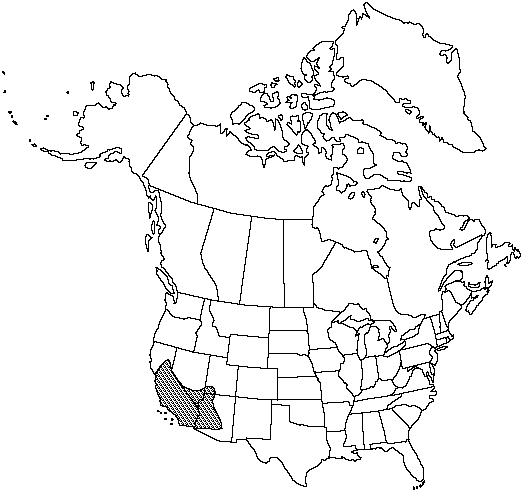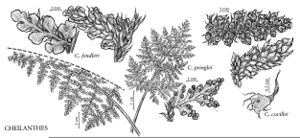Difference between revisions of "Cheilanthes covillei"
Proc. Biol. Soc. Wash. 31: 147. 1918.
FNA>Volume Importer |
imported>Volume Importer |
||
| (7 intermediate revisions by 2 users not shown) | |||
| Line 8: | Line 8: | ||
}} | }} | ||
|common_names=Coville's lip fern | |common_names=Coville's lip fern | ||
| + | |special_status={{Treatment/ID/Special_status | ||
| + | |code=F | ||
| + | |label=Illustrated | ||
| + | }} | ||
|basionyms= | |basionyms= | ||
|synonyms={{Treatment/ID/Synonym | |synonyms={{Treatment/ID/Synonym | ||
|name=Myriopteris covillei | |name=Myriopteris covillei | ||
|authority=(Maxon) A. Löve & D. Löve | |authority=(Maxon) A. Löve & D. Löve | ||
| + | |rank=species | ||
}} | }} | ||
|hierarchy=Pteridaceae;Cheilanthes;Cheilanthes covillei | |hierarchy=Pteridaceae;Cheilanthes;Cheilanthes covillei | ||
| Line 20: | Line 25: | ||
}}<!-- | }}<!-- | ||
| − | --><span class="statement" id="st- | + | --><span class="statement" id="st-undefined" data-properties=""><b>Stems </b>short-creeping, usually 2–4 mm diam.; scales usually uniformly dark brown to black or rarely with narrow, light brown margins, linear-lanceolate, straight to slightly contorted, strongly appressed, persistent. <b>Leaves</b> clustered, 5–30 cm; vernation noncircinate. <b>Petiole</b> dark brown, rounded adaxially. <b>Blade</b> lanceolate to ovate-deltate, 3–4-pinnate at base, 1.5–5 cm wide; rachis rounded adaxially, somewhat scaly, not pubescent. <b>Pinnae</b> not articulate, dark color of stalk continuing into pinna base, basal pair not conspicuously larger than adjacent pair, usually equilateral, appearing glabrous (or somewhat scaly) adaxially. <b>Costae</b> green adaxially for most of length; abaxial scales multiseriate, ovate-lanceolate, deeply cordate at base, with overlapping basal lobes, conspicuous, the largest 0.4–1.5 mm wide, strongly imbricate, usually concealing ultimate segments, ciliate only on basal lobes. <b>Ultimate</b> segments round to oblong, beadlike, the largest 1–3 mm, abaxially glabrous or with a few small scales near base, adaxially glabrous. <b>False</b> indusia marginal, weakly differentiated, 0.05–0.25 mm wide. <b>Sori</b> ± continuous around segment margins. <b>Sporangia</b> containing 64 spores. <b>2n</b> = 60.</span><!-- |
-->{{Treatment/Body | -->{{Treatment/Body | ||
| + | |phenology=Sporulating late spring–fall. | ||
|habitat=Rocky slopes, cliffs, and ledges, usually on igneous substrates | |habitat=Rocky slopes, cliffs, and ledges, usually on igneous substrates | ||
|elevation=100–2500 m | |elevation=100–2500 m | ||
|distribution=Ariz.;Calif.;Nev.;Utah;Mexico in Baja California. | |distribution=Ariz.;Calif.;Nev.;Utah;Mexico in Baja California. | ||
| − | |discussion=<p>Cheilanthes covillei can be difficult to distinguish from the closely related C. intertexta and C. clevelandii; it differs from these two species in having glabrous blades and costal scales ciliate only on the basal lobes. Cheilanthes covillei is occasionally misidentified as C. fendleri because the cilia of the scales are often obscure; it is distinguished from the latter species by having rigid, dark brown stem scales that are strongly appressed. Cheilanthes covillei hybridizes with C. parryi and C. newberryi to form rare, sterile diploids known as C. × parishii Davenport and C. × fibrillosa (Davenport) Davenport ex Underwood, respectively. A third sterile diploid hybrid with C. fendleri has recently been discovered in central Arizona (M. D. Windham, unpublished).</p> | + | |discussion=<p><i>Cheilanthes covillei</i> can be difficult to distinguish from the closely related <i>C. intertexta</i> and <i>C. clevelandii</i>; it differs from these two species in having glabrous blades and costal scales ciliate only on the basal lobes. <i>Cheilanthes covillei</i> is occasionally misidentified as <i>C. fendleri</i> because the cilia of the scales are often obscure; it is distinguished from the latter species by having rigid, dark brown stem scales that are strongly appressed. <i>Cheilanthes covillei</i> hybridizes with <i>C. parryi</i> and <i>C. newberryi</i> to form rare, sterile diploids known as C. × parishii Davenport and C. × fibrillosa (Davenport) Davenport ex Underwood, respectively. A third sterile diploid hybrid with <i>C. fendleri</i> has recently been discovered in central Arizona (M. D. Windham, unpublished).</p> |
|tables= | |tables= | ||
|references= | |references= | ||
| Line 35: | Line 41: | ||
-->{{#Taxon: | -->{{#Taxon: | ||
name=Cheilanthes covillei | name=Cheilanthes covillei | ||
| − | |||
|authority=Maxon | |authority=Maxon | ||
|rank=species | |rank=species | ||
| Line 42: | Line 47: | ||
|basionyms= | |basionyms= | ||
|family=Pteridaceae | |family=Pteridaceae | ||
| + | |phenology=Sporulating late spring–fall. | ||
|habitat=Rocky slopes, cliffs, and ledges, usually on igneous substrates | |habitat=Rocky slopes, cliffs, and ledges, usually on igneous substrates | ||
|elevation=100–2500 m | |elevation=100–2500 m | ||
| Line 48: | Line 54: | ||
|publication title=Proc. Biol. Soc. Wash. | |publication title=Proc. Biol. Soc. Wash. | ||
|publication year=1918 | |publication year=1918 | ||
| − | |special status= | + | |special status=Illustrated |
| − | |source xml=https:// | + | |source xml=https://bitbucket.org/aafc-mbb/fna-data-curation/src/2e0870ddd59836b60bcf96646a41e87ea5a5943a/coarse_grained_fna_xml/V2/V2_724.xml |
|genus=Cheilanthes | |genus=Cheilanthes | ||
|species=Cheilanthes covillei | |species=Cheilanthes covillei | ||
| − | |||
| − | |||
| − | |||
| − | |||
| − | |||
| − | |||
| − | |||
| − | |||
| − | |||
| − | |||
| − | |||
| − | |||
| − | |||
| − | |||
| − | |||
| − | |||
| − | |||
| − | |||
| − | |||
| − | |||
| − | |||
| − | |||
| − | |||
| − | |||
| − | |||
| − | |||
| − | |||
| − | |||
| − | |||
| − | |||
| − | |||
| − | |||
| − | |||
| − | |||
| − | |||
| − | |||
| − | |||
| − | |||
| − | |||
| − | |||
| − | |||
| − | |||
| − | |||
| − | |||
| − | |||
| − | |||
| − | |||
}}<!-- | }}<!-- | ||
-->[[Category:Treatment]][[Category:Cheilanthes]] | -->[[Category:Treatment]][[Category:Cheilanthes]] | ||
Latest revision as of 21:25, 5 November 2020
Stems short-creeping, usually 2–4 mm diam.; scales usually uniformly dark brown to black or rarely with narrow, light brown margins, linear-lanceolate, straight to slightly contorted, strongly appressed, persistent. Leaves clustered, 5–30 cm; vernation noncircinate. Petiole dark brown, rounded adaxially. Blade lanceolate to ovate-deltate, 3–4-pinnate at base, 1.5–5 cm wide; rachis rounded adaxially, somewhat scaly, not pubescent. Pinnae not articulate, dark color of stalk continuing into pinna base, basal pair not conspicuously larger than adjacent pair, usually equilateral, appearing glabrous (or somewhat scaly) adaxially. Costae green adaxially for most of length; abaxial scales multiseriate, ovate-lanceolate, deeply cordate at base, with overlapping basal lobes, conspicuous, the largest 0.4–1.5 mm wide, strongly imbricate, usually concealing ultimate segments, ciliate only on basal lobes. Ultimate segments round to oblong, beadlike, the largest 1–3 mm, abaxially glabrous or with a few small scales near base, adaxially glabrous. False indusia marginal, weakly differentiated, 0.05–0.25 mm wide. Sori ± continuous around segment margins. Sporangia containing 64 spores. 2n = 60.
Phenology: Sporulating late spring–fall.
Habitat: Rocky slopes, cliffs, and ledges, usually on igneous substrates
Elevation: 100–2500 m
Distribution

Ariz., Calif., Nev., Utah, Mexico in Baja California.
Discussion
Cheilanthes covillei can be difficult to distinguish from the closely related C. intertexta and C. clevelandii; it differs from these two species in having glabrous blades and costal scales ciliate only on the basal lobes. Cheilanthes covillei is occasionally misidentified as C. fendleri because the cilia of the scales are often obscure; it is distinguished from the latter species by having rigid, dark brown stem scales that are strongly appressed. Cheilanthes covillei hybridizes with C. parryi and C. newberryi to form rare, sterile diploids known as C. × parishii Davenport and C. × fibrillosa (Davenport) Davenport ex Underwood, respectively. A third sterile diploid hybrid with C. fendleri has recently been discovered in central Arizona (M. D. Windham, unpublished).
Selected References
None.
